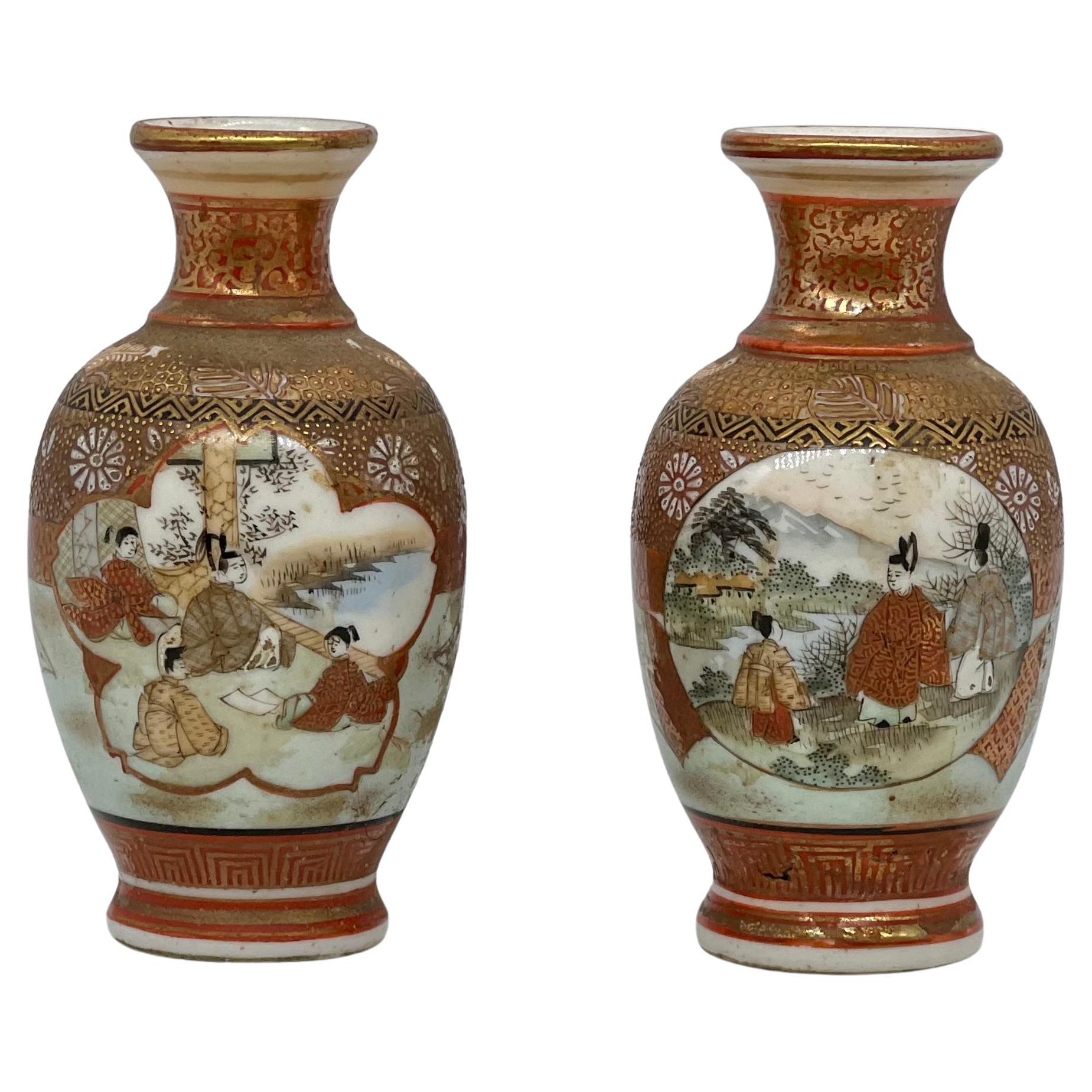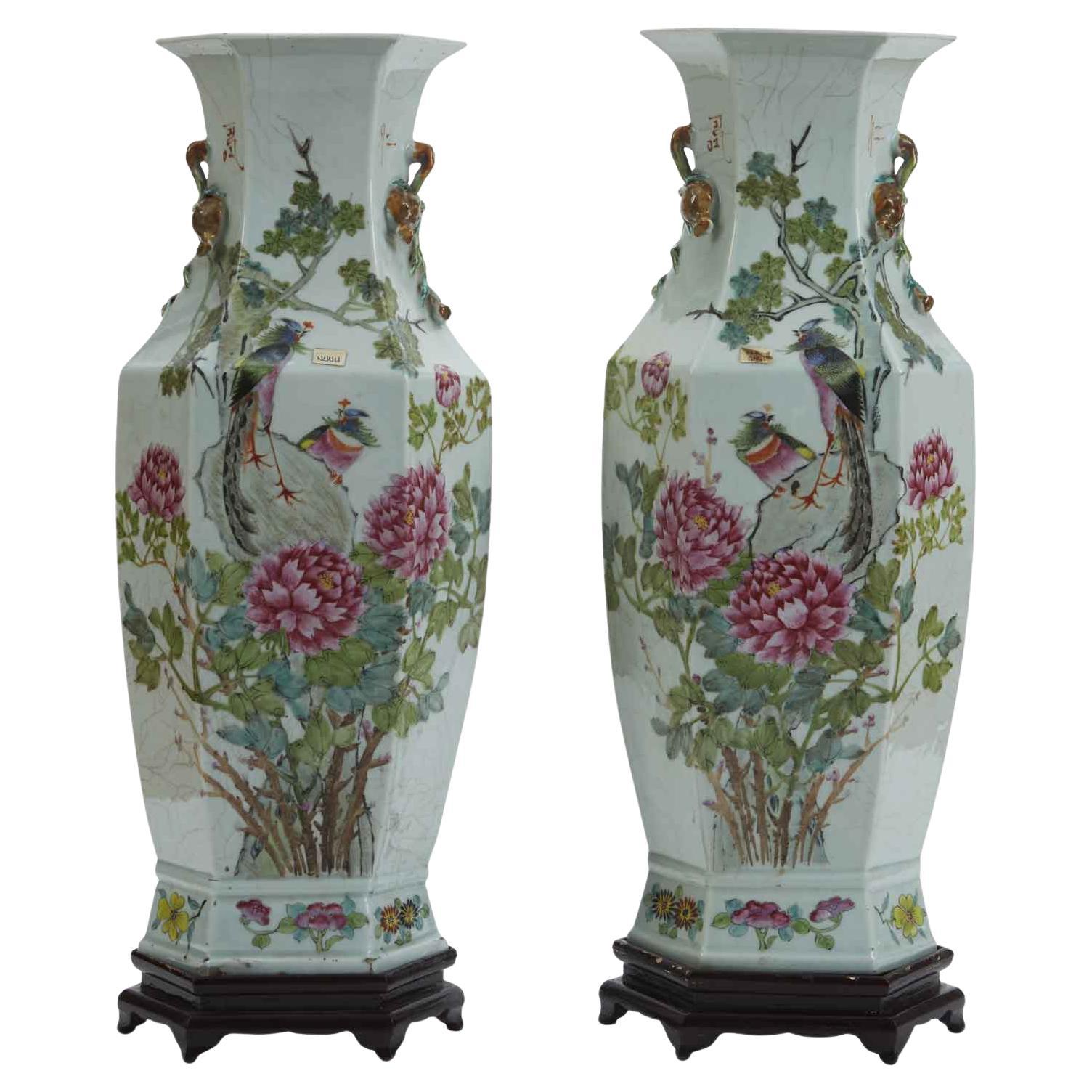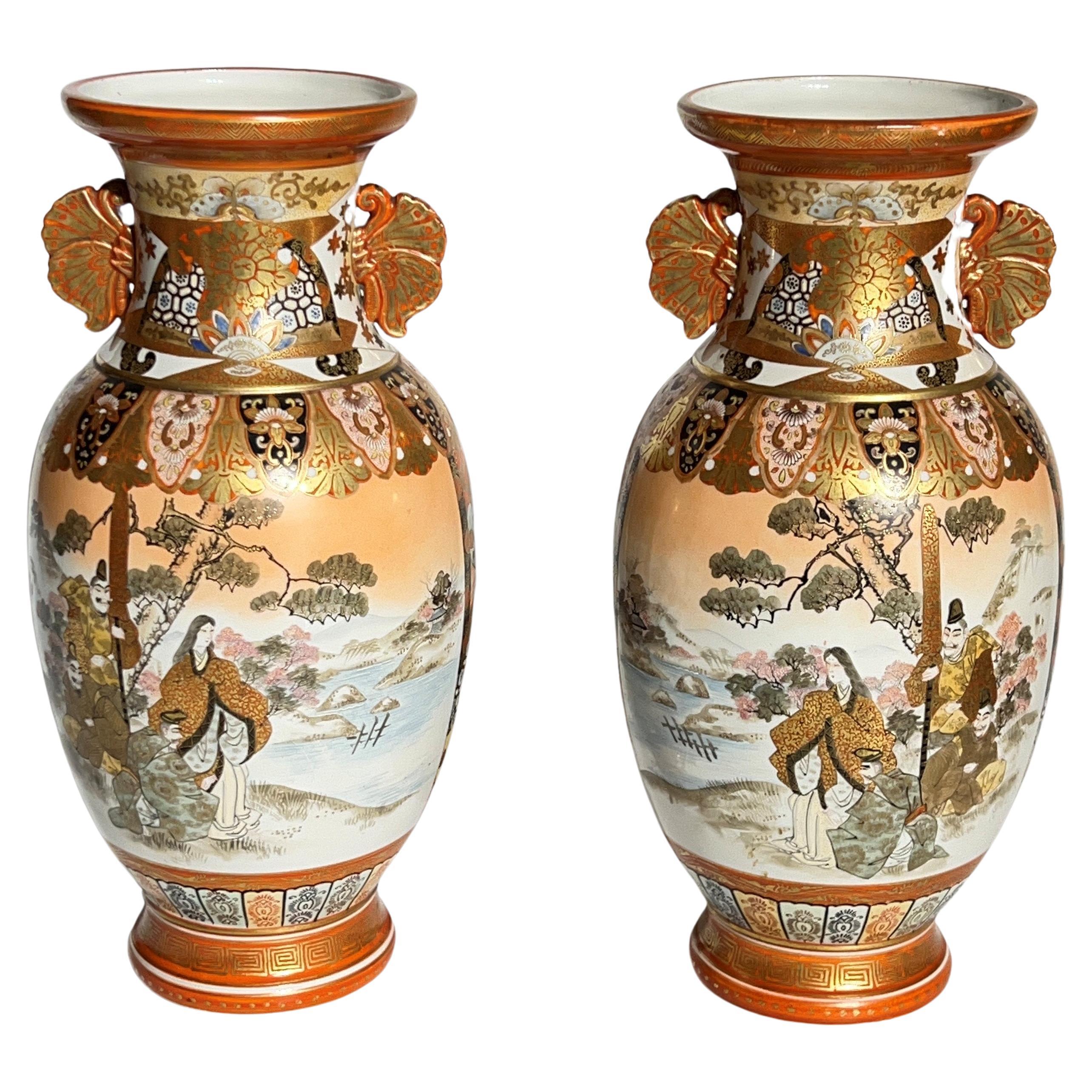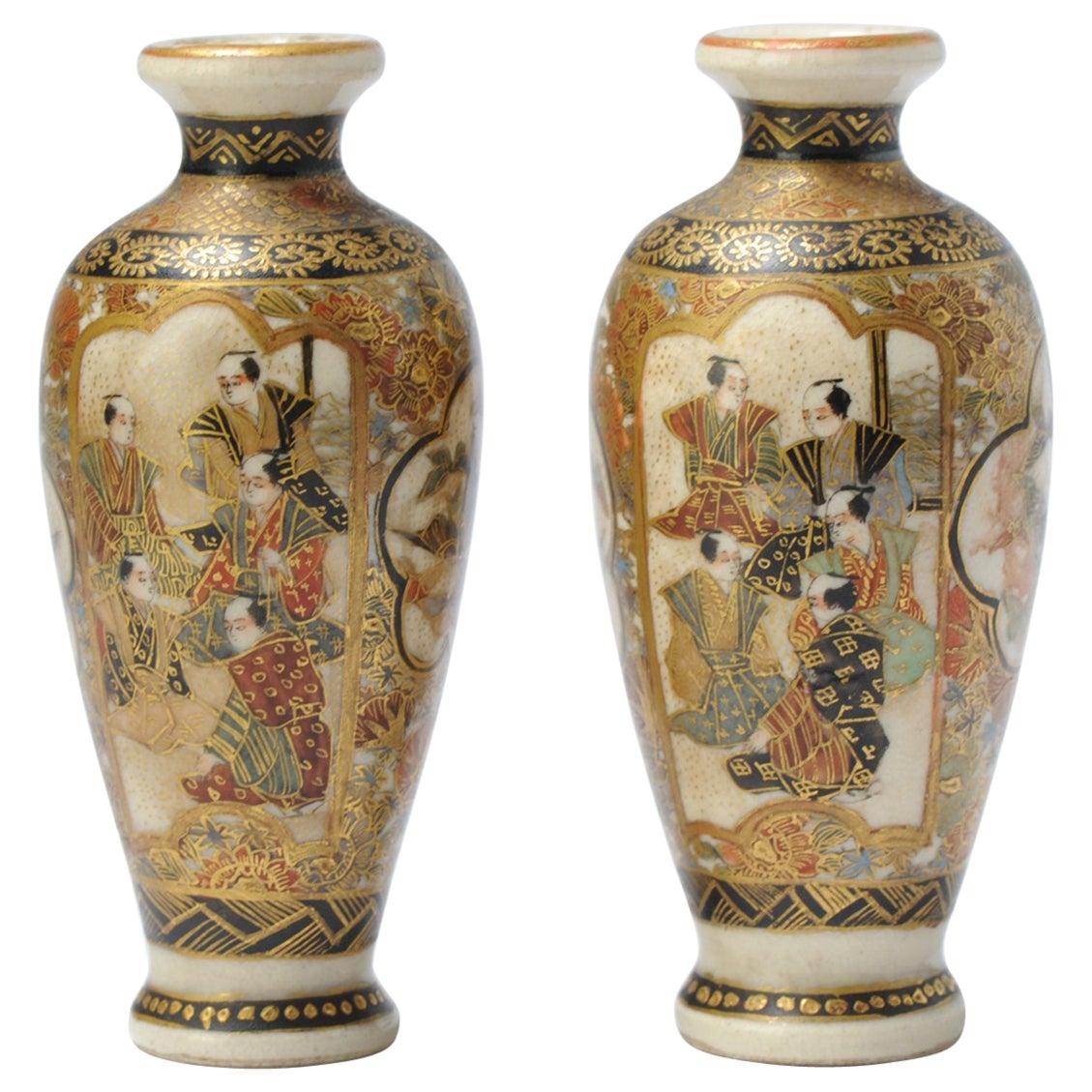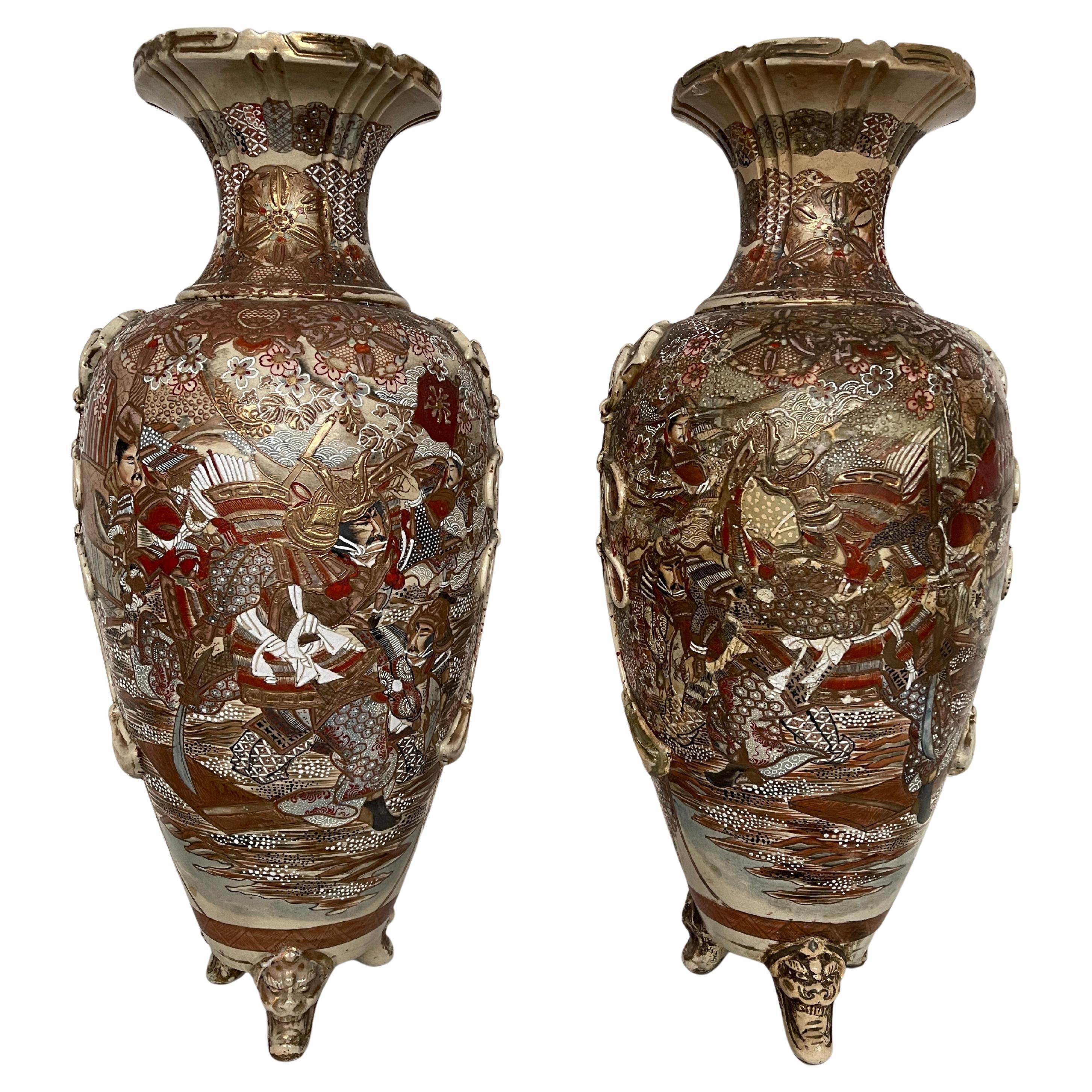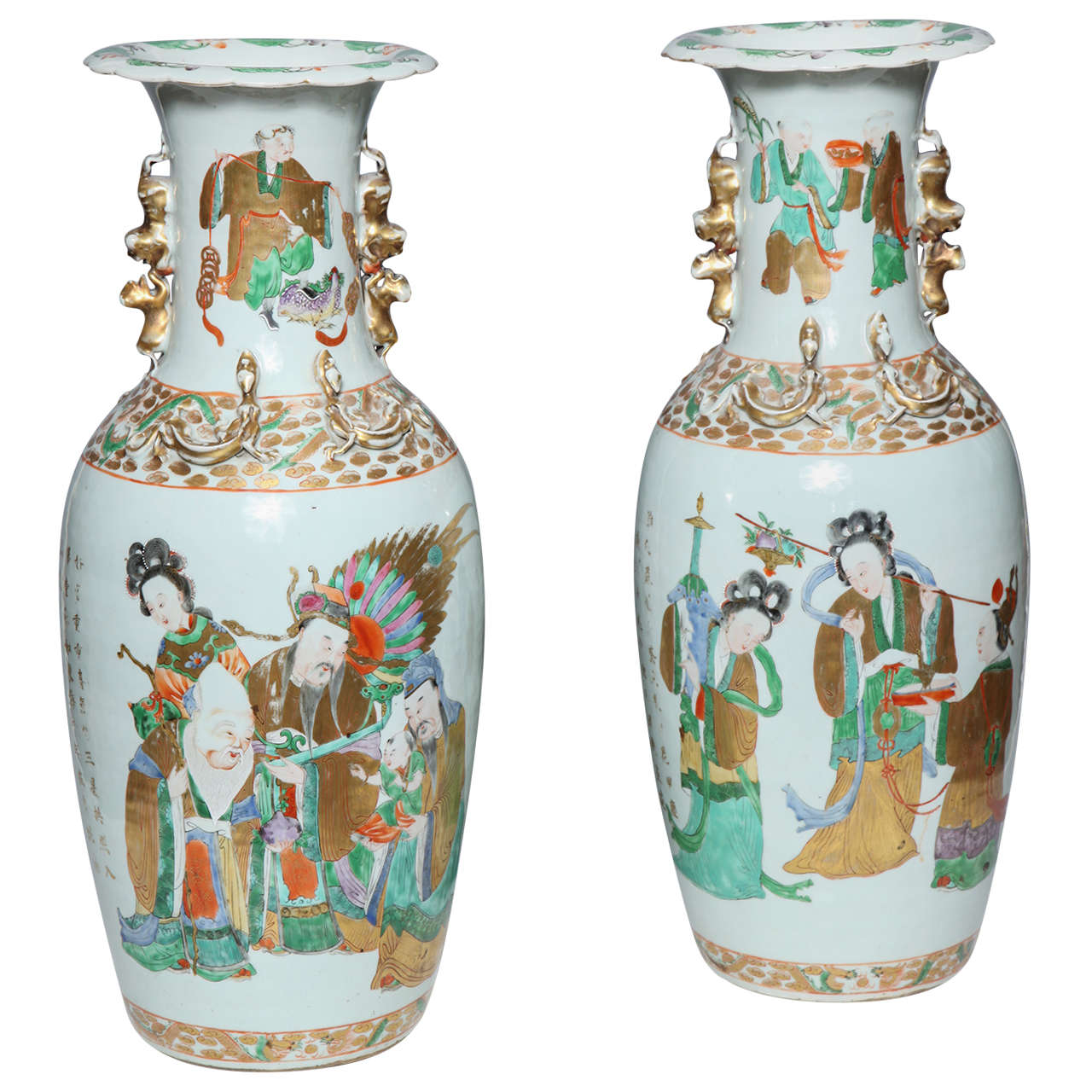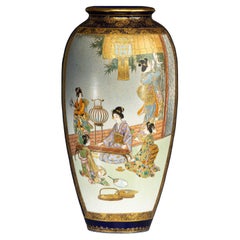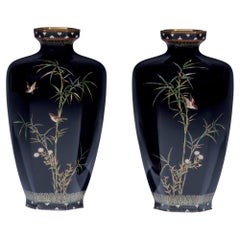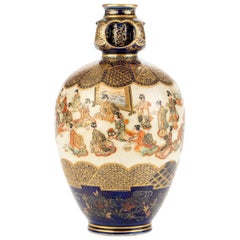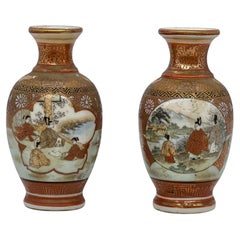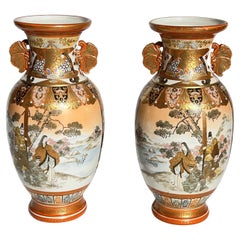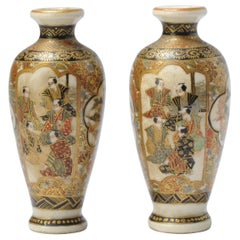Items Similar to Pair of large Satsuma vases with imperial scenes, signed Kinkozan
Want more images or videos?
Request additional images or videos from the seller
1 of 9
Pair of large Satsuma vases with imperial scenes, signed Kinkozan
$7,380.56
$9,225.7120% Off
£5,494.35
£6,867.9420% Off
€6,160
€7,70020% Off
CA$10,109.53
CA$12,636.9120% Off
A$11,244
A$14,05520% Off
CHF 5,871.27
CHF 7,339.0920% Off
MX$136,827.55
MX$171,034.4320% Off
NOK 74,985.06
NOK 93,731.3220% Off
SEK 70,322.76
SEK 87,903.4520% Off
DKK 46,893.93
DKK 58,617.4120% Off
Shipping
Retrieving quote...The 1stDibs Promise:
Authenticity Guarantee,
Money-Back Guarantee,
24-Hour Cancellation
About the Item
Pair of large Satsuma vases signed Kinkozan, decorated with scenes inspired by Japanese imperial tradition, crafted with precision and embossed gold. One side of each vase depicts the legendary Emperor Jinmu, surrounded by attendants in a solemn and ceremonial composition. On the opposite side is depicted Empress Jingū, who became during the Meiji era an emblem of female imperial power, as suggested by the phoenix on the hanging kimono, a traditional symbol of a woman's sovereign authority. Both vases bear the Kinkozan signature below the base.
Period: Meiji c. 1900.
Size: 46 x 22.5 cm.
Conservation status: Excellent condition.
- Dimensions:Height: 18.12 in (46 cm)Diameter: 8.27 in (21 cm)
- Materials and Techniques:
- Place of Origin:
- Period:
- Date of Manufacture:Meiji late 19th early 20th century
- Condition:
- Seller Location:Milano, IT
- Reference Number:1stDibs: LU9162244641162
About the Seller
No Reviews Yet
Recognized Seller
These prestigious sellers are industry leaders and represent the highest echelon for item quality and design.
Established in 2012
1stDibs seller since 2023
Typical response time: 4 hours
- ShippingRetrieving quote...Shipping from: Milano, Italy
- Return Policy
Authenticity Guarantee
In the unlikely event there’s an issue with an item’s authenticity, contact us within 1 year for a full refund. DetailsMoney-Back Guarantee
If your item is not as described, is damaged in transit, or does not arrive, contact us within 7 days for a full refund. Details24-Hour Cancellation
You have a 24-hour grace period in which to reconsider your purchase, with no questions asked.Vetted Professional Sellers
Our world-class sellers must adhere to strict standards for service and quality, maintaining the integrity of our listings.Price-Match Guarantee
If you find that a seller listed the same item for a lower price elsewhere, we’ll match it.Trusted Global Delivery
Our best-in-class carrier network provides specialized shipping options worldwide, including custom delivery.More From This Seller
View AllA Satsuma vase depicting daily life scene signed Kinkozan
Located in Milano, IT
Kyoto Satsuma vase with polychrome decoration on a cobalt blue background, embellished with gold floral motifs. A reserve shows scenes of daily life with Geisha in brightly colored k...
Category
Antique Late 19th Century Japanese Ceramics
Materials
Ceramic
$15,815 Sale Price
20% Off
Large Satsuma vase featuring representations of nobles and children
Located in Milano, IT
Large Satsuma vase with two reserves, separated by elegant floral and geometric decorations: one depicts scenes of nobility with daimyo and samurai, the other celebrates childhood wi...
Category
Antique Late 19th Century Japanese Ceramics
Materials
Ceramic
$1,725 Sale Price
20% Off
Pair of cloisonné vases attributed to Hayashi Kodenji
Located in Milano, IT
Pair of vases decorated with polychrome cloisonné enamels on a midnight blue ground, worked in silver and gold thread attributed to Hayashi Kodenji. The hexagonal body depicts sparro...
Category
Early 20th Century Japanese Metalwork
Materials
Enamel
$13,610 Sale Price
20% Off
A Satsuma vase with numerous figures bringing gift
Located in Milano, IT
Satsuma bottle-shaped vase embellished with a detailed central scene in which numerous characters bring gifts to the emperor.
The upper and lower sections of the vase are adorned wit...
Category
Antique Late 19th Century Japanese Japonisme Ceramics
Materials
Ceramic
A Large Satsuma Vase Depicting A Scene Of Daily Life
Located in Milano, IT
Large cylindrical Satsuma vase, decorated with polychrome enamels and pure gold, depicting a scene of daily life with three geishas and a samurai on a festive day.
Signed ‘Seizan zō...
Category
Antique Late 19th Century Japanese Japonisme Ceramics
Materials
Ceramic
$4,025 Sale Price
20% Off
Pair of Japanese bronze vases depicting a pair of egrets
Located in Milano, IT
A pair of Japanese bronze vases with a cylindrical shape and dark brown patina, depicting a pair of egrets near a stream, their legs dipped in water and surrounded by two flowering i...
Category
Antique Late 19th Century Japanese Metalwork
Materials
Bronze
$3,354 Sale Price
20% Off
You May Also Like
A Fine Pair of Japanese Kutani Vases. The Best of Kutani, Satsuma.Signed. Meiji
Located in London, GB
A Fine pair of Japanese Kutani Vases. Signed.
Meiji period.
A very nice pair of Japanese Meiji Period (1867-1912) baluster shaped Kutani vases decorated with images of japanese ...
Category
Antique Late 19th Century Japanese Ceramics
Materials
Ceramic, Porcelain
Pair of Chinese Hexagonal Vases 19th Century Qing Dynasty 60 cm High
Located in Milano, MI
Pair Nineteenth Century Quing Dynasty Hexagonal Chinese Vases decorated in polychrome with peonies and birds with two handles formed by fruit and racemes. In the sides, vertically, w...
Category
Antique Late 19th Century Chinese Qing Antiquities
Materials
Porcelain
Pair Japanese Kutani Porcelain Vases
Located in New York, NY
Pair of exquisite Japanese Kutani vases with fine enameled and gilt decorations, signed Kutani-Saku (九谷作), measuring 14 1/2 by 6 1/2 inches. Each in excellent condition.
Category
Antique Early 1900s Japanese Ceramics
Materials
Porcelain
$2,200 / set
Pair of Antique Beautiful Japanese Satsuma Vases Landscape Figures, 19th Cen
Located in Amsterdam, Noord Holland
Interesting and finely painted pair of satsuma vases. Very cool and of high quality.
Additional information:
Primary Material: Bronze, Porcelain & Cloisonne
Material: Porcelain & Po...
Category
Antique 19th Century Japanese Vases
Materials
Bronze
Large pair of antique Japanese imperial satsuma vases from the 19th century
By Mice di rugiano domenico e c. s.n.c.
Located in Cantù, IT
Large pair of antique Japanese imperial vases from the 19th century
Category
Antique 19th Century Japanese Meiji Garniture
Materials
Ceramic
Pair of Chinese Porcelain Vases with Painted Figures and Chinese Poems in Gold
Located in New York, NY
Pair of Chinese porcelain vases with painted figures and Chinese poems in gold. The gilt poem frames the two groups of figures who likely serve as a narrative complement to the calli...
Category
Antique 19th Century Chinese Antiquities
Materials
Porcelain
More Ways To Browse
Hand Painted Kimono
Kimono Meiji
La Fenice
Antique Hand Painted Japanese Bowl
Kangxi Blue And White Plates
16th Century Chinese Blue And White Porcelain
Antique Chinese Porcelain Clouds
Chinese Lotus Blue White
Chinese Pheasant
Kraak Porcelain
Kangxi Mark
Qianlong Mark
Antique Japanese Charger Plates
Chinese Cantonese Porcelain
Prunus Porcelain
Famille Rose Yellow
Arita Charger
Canton Enamel
